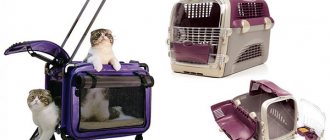Cats are homebodies and do not like to travel. But almost every owner sometimes has to transport their pets. Traveling to the vet, visiting friends on vacation, or moving to a new home can all be stressful for an animal. Even a small kitten quickly gets used to the house. Any new environment seems unusual and dangerous to him. He suddenly finds himself among many new smells, sounds, unfamiliar people and animals. Being calm while traveling doesn't mean everything is fine. The pet cannot run away or defend itself, as instinct dictates. Most likely, your pet is frozen in fear.
Even on short trips, it is advisable to ensure that the cat feels confident. This is necessary during a long journey. Otherwise, prolonged stress will lead to exhaustion of the cat’s body, the development of neuroses and serious diseases.
Proper preparation for travel will make life easier for the pet and its owners.
What vaccinations may be needed
Mandatory vaccination against rabies. It protects your pet from a deadly disease. In addition, without it it is impossible to enter the plane with the animal or cross the border of any country. It is mandatory to get vaccinated no later than 30 days before departure. During this period, antibodies are formed. In some countries, an antibody test result will be additionally required.
Viral rhinotracheitis, panleukopenia and calcivirus are fatal to cats. Sometimes the infection even gets into the apartment - on the owners’ shoes. When traveling, the risk of infection increases. It is advisable to protect your pet by getting vaccinated. In some countries, these vaccinations are required for entry.
After vaccination you will have to undergo quarantine: from 15 to 31 days. According to the requirements of the European Union - 21 days.
For the list of vaccinations required for entry, check the rules of the country you are going to. This will help avoid unpleasant surprises at the border.
I need to take my cat to the veterinary clinic, but I don’t have a carrier...
I'm afraid to carry it in my arms, because I'm already big and will break out. Tell me what to do?
I carried it in a travel bag with a zipper. She left a small gap, such that the cat could breathe, but could not jump out.
Yes, in the bosom - if the cat is smart, it will snuggle up to you and will not try to escape.
you can find a bag with a zipper anyway
Once upon a time I was bringing a cat from Hungary, a long time ago, in a box that he tore, I had to throw it away and put it in a suitcase, and even with things, the cat behaved quite well there, oddly enough. The moral is: anything that can be closed and opened will do. And then, by the way, I took him on the train on vacation and kept him on my shelf on a leash so that he wouldn’t jump around everywhere. Also very good.
What to feed your pet on the road
Even cats accustomed to traveling often refuse to eat on the road. Don't force your pet: this is normal for short trips. Feed him about six hours before leaving. In transport, animals often get sick and may vomit. On a long journey, take the usual dry food that will provide complete nutrition, for example, PROPLAN.
In a stressful situation, a kitten is able to not drink for the whole day. Try to get him drunk. Especially if you are traveling by plane or during the warmer months. Heat and dry air lead to dehydration, which is dangerous for the cat's health. At the new place, mix water with “home water”. A sudden switch to unusual water sometimes causes indigestion.
What documents are needed to transport a pet?
- Veterinary passport
with data on the animal and owner, a note on vaccinations and treatment against parasites. It can be issued at any veterinary clinic. Kittens are usually given a passport upon their first vaccination. Make sure you make notes about the drug administered and the date of vaccination. It also includes data on surgical interventions, features of color and body structure, and microchipping. To travel abroad, apply for an international passport in two languages. If you have lost your pet's document, it is better to make a new one. The clinic stores information about the procedures performed, but the stickers from the vaccine ampoules cannot be restored.
Keep in mind that document preparation takes time: take care of it in advance.
- A certificate in Form F-1
confirming that you have passed a veterinary examination is required for traveling abroad. To receive it, the cat must be in satisfactory health. All vaccinations and procedures were completed on time and included in the passport. The examination is carried out no earlier than 30 days after the last vaccination. The certificate contains information about the owner, whether the cat has undergone quarantine and an approximate travel route. Therefore, for each new trip you will have to arrange it again. Document readiness is 1-3 days. At the border it will be exchanged for an international certificate. Passing the inspection is not just a formality. It helps make sure your pet can handle the trip without harm.
The passport can be issued at any veterinary clinic, and the F-1 certificate can only be issued at the state clinic. The service is paid, the cost varies in different clinics.
How to transport a cat without a carrier
If you have to travel in a personal car and the cat has already traveled in it more than once, you can let it go in the cabin. The animal will take its usual place and calmly reach its destination. It is recommended to use a special harness to be able to fasten the animal into the seat belt slot. This will protect the owner from losing the pet at a bus stop or in another situation when the animal might run away out of fear or curiosity.
Important: you need to choose a special harness with a leash for cats. Such an accessory intended for small dogs is not suitable. In addition, it is advisable that the animal is already accustomed to wearing it.
If a cat needs to be transported without a carrier by taxi or public transport, then it will have to be secured. Transportation rules require that in any transport the cat must be transported in a carrier, basket or other container. The carrier should stand on the owner's hands or on the floor. In a taxi, it is permissible to place it on the seat, but with the driver’s permission.
How to replace a carrier
Thus, transporting a cat is only possible with the use of a device that can limit its movements. You can replace the carrier:
- sports bag. Typically, these bags are made of nylon and may have mesh inserts that will allow the animal to breathe freely. Do not fasten the zipper in such a way that the cat's head is pressed. This will lead to additional excitement and at the first opportunity the animal will run away. The bag should have a thick bottom. If it is not there, you should put some cardboard. Just like in a baby carrier, you can put toys, bedding, and a diaper in a sports bag;
- basket with a lid. It can be plastic or natural. The main condition is the presence of perforations in the walls of the basket. The basket lid should be tightly fixed;
- box. The cardboard box must be thick with a hard bottom. It is necessary to exclude the possibility of escaping from it.
- blanket, scarf, fabric. You can transport a cat without a carrier if you wrap it in a large piece of soft cloth. You need to be prepared for the fact that you will have to hold the animal tightly the whole way and make sure that it does not escape.
When transporting a cat without a carrier, it is recommended to always use a leash with a harness or collar. They will help keep your pet in any situation. After all, an excited animal can cause inconvenience not only to neighbors on transport, but also to the staff of the veterinary clinic (if you are planning a trip to a specialist). The leash, as well as the carrier, are designed specifically for the safety of your pet. They do not allow him to roam freely around the car interior and disturb the driver. They also prevent a frightened animal from running away and getting lost, getting hit by a car or getting into other troubles. However, it is worth remembering that when transporting a street or wild cat, you most likely cannot do without a carrier. And transporting cats by rail and air without a container is completely prohibited. Therefore, it is worth transporting a cat without a carrier in exceptional cases.
Travel registration
Nowadays, tickets are purchased in two ways, which determine the specifics of further actions:
Order a ticket via the Internet. As a rule, on the websites of railway companies, when purchasing a ticket, you can select all the additional functions, which include transporting a pet, which will increase the cost of the ticket.
Upon arrival at the station, you just need to show your passport and present the ticket printed from the website; When ordering a ticket through the website, pay attention to the carriages marked with the letter Z - these are the ones you need
Purchasing a ticket through the station ticket office. When purchasing a ticket directly, you inform the cashier about the presence of the animal and discuss the package of necessary documents and the final cost of the ticket, after which you redeem it.
It is advisable to notify Russian Railways employees of your intention to transport the animal in advance (two to three days before the day of departure). You can do this by calling the toll-free number 8-800-222-07-66.
The simplest procedure for transporting a cat applies to all trains
Please note that commuter trains do not require containers. It is enough to pay an additional fee for the animal, and entry into the carriage is open.
On a note
Try to make the cat as comfortable as possible. Remember that cats love cozy, soft places. To make your cat less nervous, put her favorite toy in her house; this should always be in the house. If the trip is long and you have the opportunity to make stops along the way, then in addition to warm clothes, do not forget to purchase a collar and leash for your pet so that you can walk the cat two or three times.
On the road, if the journey takes less than a day, it is better not to feed or water the cat. Your pet will easily tolerate such a “diet”.
Moving from place to place for a cat, who first of all loves the house and only then everyone who lives in it, is always a lot of stress, which can lead to temporary depression in your pet. For some time, the cat may refuse food and try to escape. Stop these actions. There were cases, reliably known, when a cat returned to its former habitat, having covered two to two and a half thousand kilometers.
Did you like the article? Subscribe to the channel to stay up to date with the most interesting materials
Source










